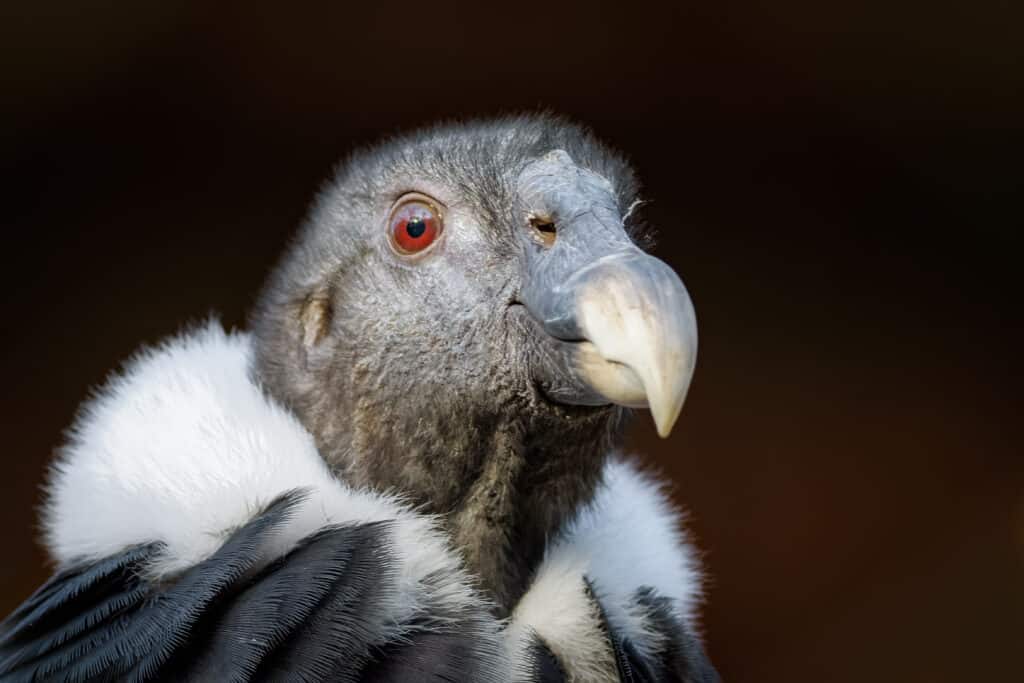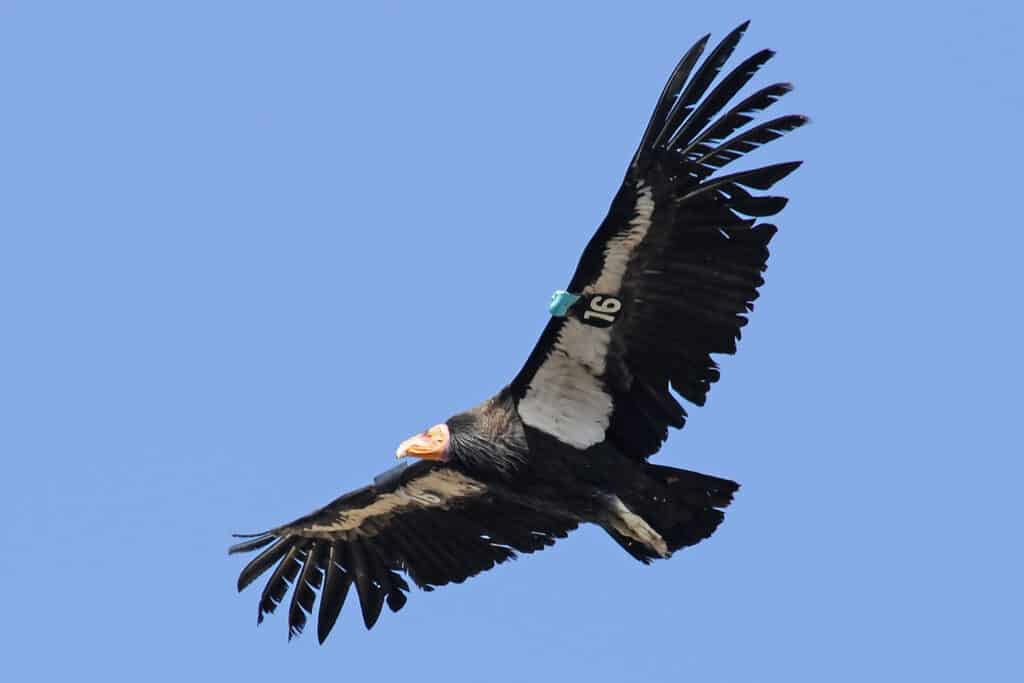As birds of prey, California condors are one of the biggest in the world, behind the Andean condor and lappet-faced vulture. They are impressive birds!
Vultures get a bad rap. Most of them have bald heads, don’t fly as well as eagles, and eat rotting carcasses. Yes, their dietary preferences are gross, but they are part of nature’s cleaning crew. Let’s dive into the details of one of the biggest birds of prey in the world: the California condor.
What IS a California Condor?

Young California condors have black heads until they mature, when they lose their white collar and gain white wing feathers.
©Thorsten Spoerlein/Shutterstock.com
California condors are vultures. These huge birds have bald, orange heads with a collar of fluffy black feathers, dark body feathers with white feathers on the underside of their wings. Young condors have black to gray heads until they mature and gain their white wing feathers and lose their white collar.
Although they are birds of prey, they’re not designed for hunting. Condors soar through the air for hours, searching for an easy meal. By riding thermal drafts and air currents, California condors can soar at 15,000 feet in altitude and reach speeds of 55 miles per hour.
Like other birds of prey, they nest high in trees and along cliffs. However, they only lay one or sometimes two eggs per nesting season.
Where California Condors Live
Historically, they ranged across much of the continent, from California to New York. Early settlers even reported seeing them in British Columbia.
Yet, human westward expansion saw the demise of many condors through poisoning, shooting, and reduction of food sources. Some people collected their eggs for food themselves and many people misunderstood that condors do not kill livestock. They believed the huge vultures were a threat to their livestock, animals, and even children.
Today, conservationists work to educate people on both the necessity of these rotten meat-eating birds and that they’re not out to get your pets. California condors live in mountainous regions of California, Arizona, Utah, and Baja Calfornia, Mexico.
California Condor Diet
They won’t take your little dog out of the back yard anymore than they’d hunt a deer for dinner. They may, however, bully other predators to steal a kill!
Just like other vultures, California condors thrive on carrion — dead and sometimes rotting animals. In fact, that is all they eat! Their stomach acid is so strong it kills the pathogens that would kill most other predators. The bulk of their diet includes large animals like dead cattle, sheep, deer, and elk. These vultures need big prey items to support a large body and feed their babies, but they’re open to eating just about anything, as long as it’s dead.
How Big Are California Condors?
Put simply, they’re big. When you see one in a zoo you can see their true size. In a trip to the San Diego Zoo Safari Park, it’s easy to see a few condors and understand why people may have been frightened of them. But, if you can’t get out there, they have a CondorCam for you to view them live.
A California condor can stand over four feet tall with a wingspan of 8.5 to 9.5 feet. That’s tall enough to get onto most theme-park rides, with wings that spread farther than most sofas are long. Or if you prefer, taller than the typical eight-foot ceiling height in a house.
They’re not lightweights either. These birds can weigh over 30 pounds, the same as six bags of flour.
California Condor Conservation

California condors can soar for hours, riding the wind currents while they look for food.
©Brian A Wolf/Shutterstock.com
In 1987, the last wild California condor was taken into captivity. At that time, there were only 27 in the entire world. Yes, 27! There is no missing zero in the number. The Los Angeles Zoo and San Diego Wild Animal Park cared for them, bred them, and began releasing them back into the wild in 1992 and by 1994, captive birds had laid more than 100 eggs!
As of the most recent report for 2020, the recovery is astounding! There are at least 504 California condors worldwide and 329 of those are in the wild, living in Arizona, Utah, California, and Baja California, Mexico.
Zoologists and conservation groups continue to breed and release these critically endangered birds into the wild. We may never see them completely repopulate their previous range, because there isn’t enough food or nesting sites. But, they’re recovering. For a species on the brink only 40 years ago, that’s a huge success — and the work continues!
The photo featured at the top of this post is © Barbara Ash/Shutterstock.com
Thank you for reading! Have some feedback for us? Contact the AZ Animals editorial team.







